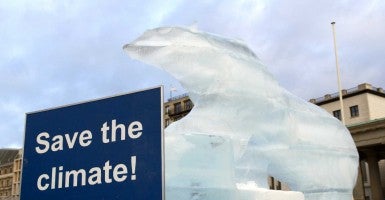As world leaders remain locked in on the threat of ISIS, the U.S. Department of Defense laid out its plan to fight a different battle: ice caps.
In a new report, DOD argues that climate change poses “immediate risks to U.S. national security” because of warmer temperatures, rising sea levels, changing precipitation patterns and more frequent and intense storms. There are just two small problems with such an assertion. One, none of these climate challenges are actually occurring in amounts that would present an immediate risk. Two, the administration’s economy-crushing carbon regulations that would choke off affordable energy sources wouldn’t make a difference even if climate change did pose a threat.
Let’s go through them one by one. Accelerated warming? Not so much. October 2014 marks the 18th year that there’s been no trend in global warming during a time when global carbon emissions have increased and climate models predicted accelerated rates of warming. No immediate risk there.
Rising sea levels? That’s happening, but it comes nowhere near posing an immediate risk and in fact, has slowed in recent years. A recent paper published in Nature Climate Change found that “since the early 1990s, sea level rose at a mean rate of 3.1 millimeters per year. Over the last decade, this rate slowed by about 30 percent.
Indeed, the 3.1-millimeter-per-year increase is actually on par with the past century’s level of rising sea levels and it has since slowed down. Furthermore, climatologist Judith Curry says “It is clear that natural variability has dominated sea level rise during the 20th century, with changes in ocean heat content and changes in precipitation patterns.”
DOD warns us that “in places like the Hampton Roads region in Virginia, which houses the largest concentration of U.S. military sites in the world, we see recurrent flooding today, and we are beginning work to address a projected sea-level rise of 1.5 feet over the next 20 to 50 years.”
That’s 457.2 millimeters of sea level rise over the next 20 to 50 years. That’s an increase of either 22.86 millimeters per year for 20 years or 9.1 millimeters per year for 50. Neither projection is anywhere close to climate reality, which tends to be the theme of the DOD report.
How about more frequent and intense storms? DOD argues that with more hurricanes, floods and droughts, the Department of Defense will have to spend money and deploy resources differently. More frequent and intense storms could cause problems such as “increased dust generation during training activities” or “increased inundation, erosion and flooding damage. And there could be threats to food and water supplies and the need for more resources for humanitarian assistance and disaster relief.
That may sound reasonable if any trends actually existed for increased natural disasters. But even the Intergovernmental Panel on Climate Change report, which the Obama administration hails as the magnum opus, concludes these threats do not exist or are not immediate.
IPCC says, “Current data sets indicate no significant observed trends in global tropical cyclone frequency over the past century, and it remains uncertain whether any reported long-term increases in tropical cyclone frequency are robust, after accounting for past changes in observing capabilities.”
Droughts aren’t a problem, either, according to the IPCC: “In summary, the current assessment concludes that there is not enough evidence at present to suggest more than low confidence in a global-scale observed trend in drought or dryness (lack of rainfall) since the middle of the 20th century.” IPCC drew similar conclusions on floods: “In summary, there continues to be a lack of evidence and thus low confidence regarding the sign of trend in the magnitude and/or frequency of floods on a global scale.”
The climate is changing, and the extent to how much manmade emissions are contributing is highly debated. But what is clear is that climate change is not imposing the immediate risk that the DOD purports. Even more troubling, the regulations restricting America’s energy use to combat climate change will do nothing but reduce economic growth and resources available for either humanitarian efforts or to grow international economies.
Moreover, the DOD using resources to address non-problems reduces the department’s ability to address real national security threats such as ISIS or ebola. Additionally, the gradual occurrence of climate change will provide DOD plenty of time to adjust any changing conditions and humanitarian efforts.
Secretary of Defense Chuck Hagel remarked that “Climate extremes in Australia are worrying leaders there.” Well, they apparently aren’t too worried because the Australian government, recognizing the economic hardship its carbon tax imposed on its families and businesses, decided to repeal it.
Military preparedness for changing climates and different circumstances that our armed forces must face is one thing. But to pose climate change as an immediate risk when evidence suggests otherwise is nothing short of fear-mongering, woeful ignorance and politicization.
































One Reply to “Hey, Defense Department: Focus on ISIS, not Climate Change”